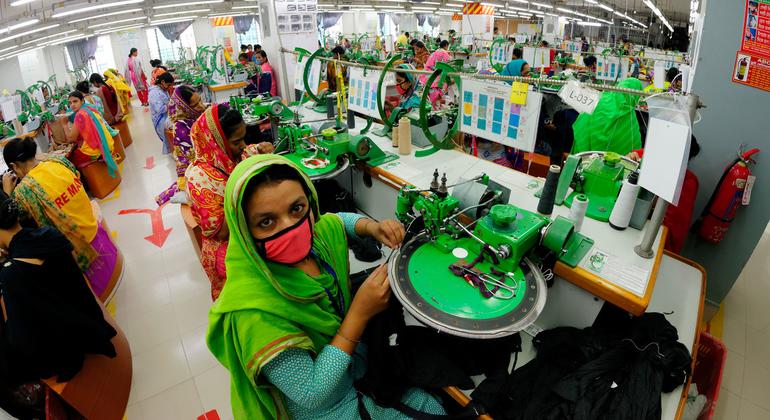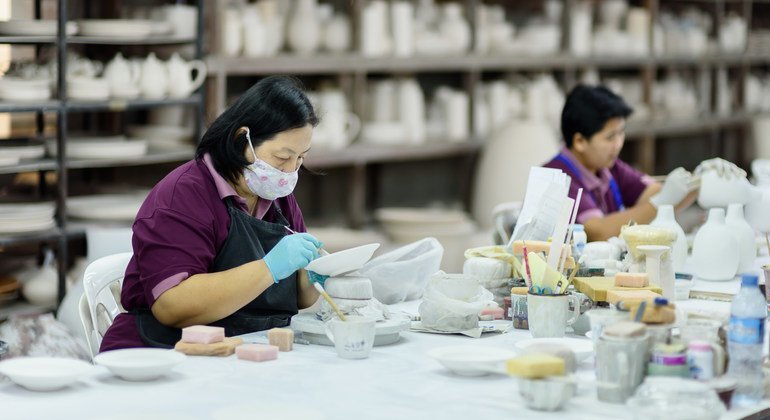Not Much Progress: Women’s Jobs and Pay Stagnant for Two Decades
 In a new blow for equality in the 21st century workplace, UN labour experts said on Monday that women’s access to jobs, their employment conditions and a persistent pay gap, have barely improved worldwide in nearly two decades.
In a new blow for equality in the 21st century workplace, UN labour experts said on Monday that women’s access to jobs, their employment conditions and a persistent pay gap, have barely improved worldwide in nearly two decades.
The jobs gap for women is a “stubborn and damaging reality of the global labour market” but it is particularly worrying in developing countries, the International Labour Organization (ILO) said, with almost one in four women unable to find a job, compared with 16.6 per cent of men.
Tweet URL
‘Bleaker picture’
That assessment is based on new data gathered from all people looking for work, as opposed to those registered as unemployed.
“It paints a much bleaker picture of the situation of women in the world of work…(it) shows that women still have a much harder time finding a job than men,” ILO said.
According to the UN agency, 15 per cent of working-age women globally would like to work but do not have a job, compared with 10.5 per cent of men, whereas unemployment levels are very similar for both sexes, “because the criteria used to define unemployment tend to disproportionately exclude women”.
Held back
Personal and family responsibilities, including unpaid care work are among the reasons why women are disproportionately affected in the search for work.
“These activities can prevent them not only from being employed but also from actively searching for employment or being available to work at short notice,” ILO said, adding that these requirements are a pre-requisite for unemployment registration.
Highlighting how the jobs gender gap has remained almost unchanged between 2005 and 2022, ILO pointed out that women continue to be overrepresented in many vulnerable sectors, such as running their households or working for relatives, rather than for themselves.
“This vulnerability, together with lower employment rates, takes a toll on women’s earnings,” the UN agency said. “Globally, for each dollar of labour income men earn, women earned only 51 cents.”

UN Women/Pornvit Visitoran
Male pay bias
Significant differences exist between regions, with low and lower-middle income countries seeing far worse gender disparity in income, with women earning 33 cents and 29 cents on the dollar, respectively.
In high-income and upper-middle income countries, women’s relative labour income reaches 58 and 56 cents respectively per dollar earned by men.
“Gender imbalances in access to employment and working conditions are greater than previously thought, particularly in the developing world…the pace of progress is disappointingly slow,” said ILO.
According to the UN labour agency, the global unemployment rate stood at 5.8 per cent in 2022, below the average rates in the two decades before the pandemic, and it is projected to remain at that level in 2023.
Lila Montgomery is a celebrated journalist who has a deep commitment to global affairs and humanitarian issues. Her extensive reporting on United Nations initiatives across the globe has brought critical stories to the forefront, stories that affect communities everywhere.




The jobs gap for women is a “stubborn and damaging reality of the global labour market” but it is particularly worrying in developing countries, the International Labour Organization (ILO) said, with almost one in four women unable to find a job, compared with 16.6 per cent of men. ‘Bleaker picture’ That assessment is based on new data gathered from all people looking for work, as opposed to those registered as unemployed. “It paints a much bleaker picture of the situation of women in the world of work…(it) shows that women still have a much harder time finding a job than men,” ILO said. According to the UN agency, 15 per cent of working-age women globally would like to work but do not have a job, compared with 10.5 per cent of men, whereas unemployment levels are very similar for both sexes, “because the criteria used to define unemployment tend to disproportionately exclude women”. Held back Personal and family responsibilities, including unpaid care work are among the reasons hindering women’s progress in the workforce.
“It paints a much bleaker picture of the situation of women in the world of work…(it) shows that women still have a much harder time finding a job than men,” ILO said.
Do you think there are specific reasons why women’s access to jobs and pay have stagnated for so long, as mentioned in the article?
I believe there are multiple factors contributing to the stagnation of women’s access to jobs and pay. Deep-rooted gender biases, lack of equal opportunities, and societal expectations all play a role in perpetuating this inequality. It’s imperative for policymakers and businesses to address these systemic issues to create a more inclusive and fair workplace for everyone.
Does this lack of progress highlight the need for more targeted policies to address women’s access to jobs and pay equality?
Yes, indeed, EmilySmith92. The stagnation in women’s job opportunities and pay underscores the urgency for focused policies aimed at enhancing women’s access to equal employment and fair pay. Addressing this issue is crucial for achieving gender equality in the workforce.
The report paints a bleak picture of the situation for women in the workplace. It’s disheartening to see that women still face significant challenges in finding employment compared to men. The jobs gap remains a stubborn issue that needs urgent attention to achieve true gender equality.
The stagnation of women’s jobs and pay is truly disheartening. It’s disheartening to see that access to jobs, employment conditions, and the pay gap have barely improved for women worldwide in the past two decades. The jobs gap for women is a stubborn reality that needs urgent attention, especially in developing countries. We must strive for true equality in the workplace for all.
It’s disheartening to see that despite progress in many areas, the jobs gap for women remains a stubborn and damaging reality globally. The data clearly shows that women continue to face significant challenges in accessing employment opportunities compared to men. This issue must be addressed urgently to create a more equitable workforce for all.
The jobs gap for women is a “stubborn and damaging reality of the global labour market” but it is particularly worrying in developing countries, the International Labour Organization (ILO) said, with almost one in four women unable to find a job, compared with 16.6 per cent of men.
It’s disheartening to see that women’s access to jobs and their pay have barely improved in two decades. The jobs gap for women remains a stubborn and damaging reality worldwide, especially in developing countries. It’s high time for significant changes to close this gap and achieve true gender equality in the workplace.
The jobs gap for women is a “stubborn and damaging reality of the global labor market” but it is particularly worrying in developing countries. It paints a much bleaker picture of the situation of women in the world of work, showing that women still have a much harder time finding a job than men.
The stagnation in women’s jobs and pay over the past two decades is disheartening. It is disheartening to see that despite efforts for equality, women still struggle to access jobs and face persistent pay gaps. This situation is a stark reminder that there is so much more work needed to achieve true gender equality in the workplace.